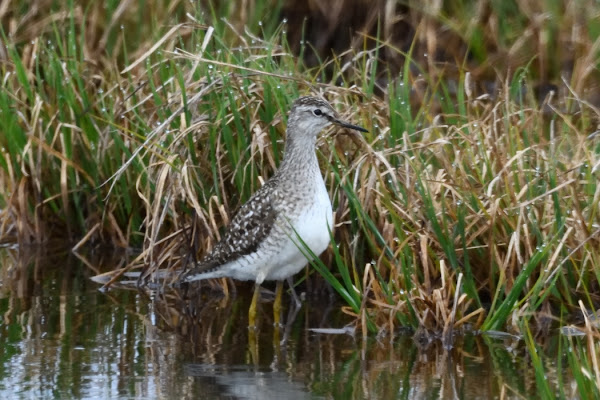We started the day by checking the "Landing Lights" area. Three Ruddy Turnstones were on the beach with around 30 Rock Sandpipers.
While driving through Contractors Camp Marsh, I spotted a Wood Sandpiper, which let me get some photos of it.
We took pictures of each other at the "Adak National Forest", which is a small grove of spruces and some willows where Frank set up one of his several feeders.
It was raining on the way up to Clam Lagoon. We stopped to take a photo of a rainbow that appeared for the short time that the sun shone through a hole in the clouds.
The tide was high when we got to the lagoon. A fairly close Marbled Murrelet and a Common Eider were photographed in between dives.
Arctic Terns and Pelagic Cormorants were also seen along the north end of the lagoon.
A Pacific Loon was present along "The Seawall".
A very skittish Bar-tailed Godwit was also seen on the beach there.
In the afternoon, we birded Sweeper Cove. Three Black Oystercatchers flew past us and landed with two others on the rocky shore.
Six Horned Puffins and 9 Pigeon Guillemots were also flying around between the piers while 4 Ancient Murrelets and a Common Murre were farther out on the water.
I got a very nice photo of a Common Teal, or "Eurasian" Green-winged Teal, along Sweeper Creek.
We returned to Clam Lagoon. This time, the tide was pretty low and was still going out when we reached Candlestick Bridge.
The next three photos of Clam Lagoon were taken panoramically from southwest to north during close to low tide.
A group of Harbor Seals were on the tidal flats above the Candlestick Bridge.
Unfortunately, nothing new was found on our afternoon run. This photo, taken from the "Palisades Overlook", shows Clam Lagoon on the left and Kuluk Bay on the right.
We went back to the house, had dinner, and then headed back out. I asked Frank to drop me off at the "Landing Lights" while he watched from the nearby Airport Creek spot. That's when he realized that he had forgotten his camera. So, I walked out to the landing lights while he drove back to the house. As I reached the lights, I saw a flash of black and white go behind a rock. My first impression was a White Wagtail, but whatever it was had dropped out of sight. I kept watching the area. A Ruddy Turnstone posed on a rock.
Another Ruddy Turnstone then appeared from behind a rock near where I had seen the black and white bird, so I wondered if that was what I had seen, but I still had my doubts. A couple minutes later, a bird flew in from the left edge of the rocks and landed right in front of me. It WAS a White Wagtail! I quickly blasted several photos of it.
Then I called Frank on the radio, but I wasn't getting a reply. I called again, announcing "White Wagtail at the Landing Lights!" This time, Frank and one of the other birding groups heard me. That's when the bird took off and flew north up along the Navfac Beach. I watched it until it got so far up that I lost it against the similar-colored beach. The others arrived and I told them the bad news that the bird had flown north. We all drove about a mile up to the top end of the beach and walked back towards the lights but, unfortunately, the bird was gone.
Bar-tailed Godwit, Ruddy Turnstone, and the White Wagtail were the additions seen today, putting the trip list at 58 species.








































No comments:
Post a Comment